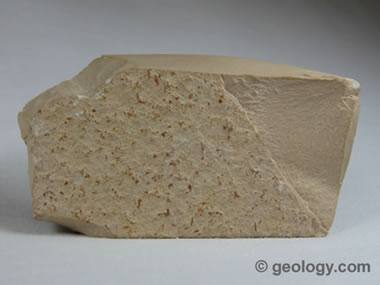Anhydrite
An evaporite mineral used as a soil treatment and to produce construction materials
What is Anhydrite?
Anhydrite is an evaporite mineral that occurs in extensive layered deposits in sedimentary basins where large volumes of sea water have been evaporated. It is typically interbedded with halite, gypsum, and limestone in accumulations that can be up to hundreds of feet thick. On a much smaller scale, anhydrite can form in shoreline or tidal flat sediments from the evaporation of sea water.Anhydrite also occurs as a vein-filling mineral in hydrothermal deposits. It is deposited from solution, often along with calcite and halite, as gangue in sulfide mineral deposits. Anhydrite is also found in the cap rock of salt domes and in cavities of trap rock.
Anhydrite is an anhydrous calcium sulfate with a composition of CaSO4. It is closely related to gypsum, which has a chemical composition of CaSO4.2H2O. The worldwide abundance of gypsum greatly exceeds the abundance of anhydrite.
Anhydrite receives its name from the Greek "anhydrous" which means "without water." It readily converts to gypsum under humid conditions or in contact with groundwater. This transition involves the absorption of water and a significant change in volume. That expansion can cause deformation in the rock units. If gypsum is heated to about 200 degrees Celsius, it will yield water and be converted to anhydrite. This reaction occurs much less often.
Physical Properties and Identification
One of the most distinctive properties of anhydrite is its cubic cleavage. It cleaves in three directions at right angles. This can easily be seen in coarsely crystalline specimens or with a hand lens in fine-grained specimens. This distinctive cleavage has earned anhydrite the nickname of "cube spar."Anhydrite can be a small challenge to identify when it occurs in massive form. It can be confused with gypsum, calcite, or halite - which it is almost always associated with. Compared to gypsum, anhydrite exhibits cleavage in three directions at right angles and has a greater hardness. Its right angle cleavage and lack of acid reaction allows it to be distinguished from calcite. Compared to halite, anhydrite is insoluble and slightly harder.

Anhydrite: Anhydrite from Mound House, Nevada
with a very fine texture that could be confused with lithographic
limestone. Specimen is approximately 4 inches (10 centimeters) across.
Uses of Anhydrite
Anhydrite can be substituted for gypsum in some of its uses. Both minerals are crushed for use as a soil treatment, and in this purpose anhydrite is superior. One ton of anhydrite has more calcium than one ton of gypsum - because gypsum is about 21% water by weight. This yields more calcium per ton in a soil application. Anhydrite also has a higher solubility, which helps it benefit the soil quickly.Small amounts of anhydrite are used as drying agents in plaster, paint, and varnish. It is also used along with gypsum to produce plaster, joint compound, wallboard, and other products for the construction industry. Anhydrite has also been used as a source of sulfur in the production of sulfuric acid.
By: https://geology.com/minerals/anhydrite.shtml
Description
Anhydrite, or anhydrous calcium sulfate, is a mineral with the chemical formula CaSO₄. It is in the orthorhombic crystal system, with three directions of perfect cleavage parallel to the three planes of symmetry.
Specific gravity: 2.97
Crystal class: Dipyramidal (mmm); H–M symbol: (2/m 2/m 2/m)
Mohs scale hardness: 3.5
Optical properties: Biaxial (+)
Cleavage: perfect, perfect, good, resulting in pseudocubic fragments
From: Wikipedia
Thanks to the Wikipedia and geology.com
To give me more knowledge
Thanks to the Wikipedia and geology.com
To give me more knowledge
Comments
Post a Comment